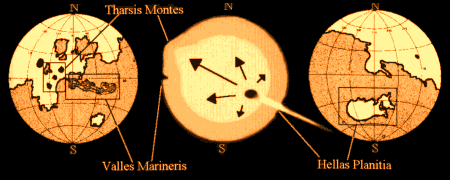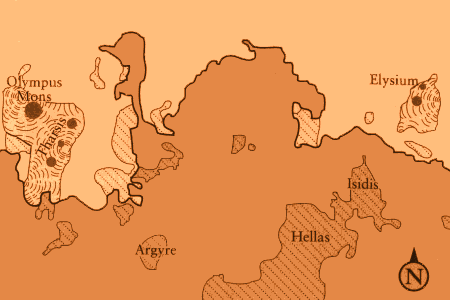
|
Distance
from the Sun |
mil km | 227.94
| | mil miles | 141.6
|
Orbital Period
(length of year) |
Earth days | 686.98
| | Earth years | 1.881
|
Local Days per Year
rotations per orbit |
669.77
|
Length of day
in Earth Time |
24h 37m
|
|
| Axial Tilt |
25.19�
|
Orbital Inclination
from Earth's orbit |
1.850�
|
Orbital Eccentricity
from circular |
0.0934
|
Sidereal Rotation
in Earth days |
1.025957
|
| Mean Orbital Velocity km/s |
24.13
|
|
| Visual Geometric Albedo |
.15
|
Vo or Object's Visible
Magnitude at Opposition |
-2.01
|
|
| Mean Radius km |
3,397.2
|
Mean
Diameter
at Equator |
km |
6786
|
| miles |
4,219
|
| x Earth |
.533
|
|
| Mass |
kg | 6.421 e+23
| | x Earth | .1074
|
| Density (grams per cm3)
| 3.94
|
| Gravity x Earth |
.38
|
| Escape Velocity in km per sec
| 5.0225
|
|
|
|
Mars, the god of war. The Red Planet. The fourth planet out from the sun was once very much like ours is today, and may yet be again.
While temperatures are very cold, and the atmosphere is very thin, this is all potentially malleable.
Our own experiences with the Greenhouse Effect could be a great lesson on how to manufacture an intentional Global Warming
- but this time for a better reason than the proliferation of styrofoam,
and hopefully while we repair and restore our own planet's atmosphere and ozone layer.
Perhaps in as little as a hundred years (from date of inception),
a breathable atmosphere could be created, making colonization that much easier.
A clean slate, as it were.
Mars has two very tiny moons, Phobos and Diemos
- each are potato shaped, and only about the size of a large Earth city,
which leads most to suspect that they are most likely captured asteroids;
a not entirely unheard of event, possibly arising from the same ancient cataclysm
which eradicated the Martian atmosphere and created some of the more prevalent surface features
- such as Valles Marineris (which makes the Grand Canyon look like a tire track in the mud)
and a chain of giant volcanoes (among the largest in the Solar System) including Olympus Mons.
The opposite side of the planet (antipolar) from these massive mountains
are the three largest craters on Mars, known to less formal Mars scientists as "The Bullet Wounds"
- asteroidial entry portals into the living core of a now half-dead planet,
the magnetic field of which seems to also have changed dramatically,
as would anyone's under such conditions.
|
|
| |
|
|
| Year
disc. |
| Distance
(in miles) |
| Revolution
(in days) |
| Mass
(x Luna) |
| Density |
| Diameter
(in miles) |
| Phobos | 1877 | 5,840 | 0.319 | | .00000018 | 1.9 | 12 x 8 | |
| Diemos | 1877 | 14,602 | 1.263 | .000000024 | 2.1 | 7 x 6 |
| |
|
|
Phobos and Diemos are sorry softballs, as moons go
- covered in black dust that would get all over everything if you tried to play softball there.
Your first pitch would easily go into orbit around either pebble
- and as you run the bases, the hard part would be touching the bag, or changing direction,
as any steps you'd take would lift you above the surface, gracefully avoiding anything that resembles a landing.
It would not be difficult for someone with muscles to break free from their gravity.
Be careful you don't go flying off into space.
|
|
|
 |
| Mars Asteroid Collision Disaster Theory |
| Mars Terrain Dichotomy |
 |
|
|
Mars has radical elevation differences
- making any future oceans isolated to mainly one side of the planet.
It seems as if nearly half of the Martian crust was suddenly blown out into space
only to rain down upon anything that was still left recognizable on the ground.
Almost everywhere on the surface are traces of massive, short-lived flash flooding.
As the atmosphere was blown away, its pressure dropped significantly
- causing whatever water there was present on the surface to suddenly evaporate (perhaps on its way down hill);
although one has dim hopes of some oxy-hydro potential moisture somehow surviving in the permafrost, or even underground.
The first thing you will notice when touring the Martian sites
is the resemblance to architecture that many natural formations still vainly cling to.
Do not be persuaded by this, or even tempted to compare a "style" to anything of that from ancient Earth.
For example: if you were in Cydonia, standing in the shadow of what appear to be Pyramids,
you might note their apparent arrangement on a grid with proportions of one to the square root of two,
which is also aligned to the cardinal points
- and is one of the more notable departures from nature's tendency to be more or less fractal.
As you approach that outcropping comically referred to as "The Face"
and make your way down the cobblestone walkway towards the mighty arched gateway portal inside,
you might be tempted to envision the similarity of a common crater to an olympic sized wading pool.
Instead, be aware that Human faces are also considered to be more or less natural in origin;
and any outward mentionings of these coincidences
will be grounds for you to be removed from the list of Humans deemed eligible to stay, or even go in the first place.
Point of fact: Humans were never on the planet Mars and every sane person openly laughs at such talk.
Spacedog is well aware of the exact date of the creation of the Human race, some 5000 odd years ago
- in fact, he created them, and thus enabled the mechanism for the creation of us.
Read on, dear mortals. Read on.
When Humans begin to colonize and further explore the Red Planet in the early 22nd Century
they will no doubt look back on this era and laugh, and smack their foreheads,
and nod, and shake their heads, and sigh, and look way up to the sky, and finally... begin to cry.
But give a pause of relief - even at the cost of ridiculing those who have discovered the seemingly ridiculous
- for it is better that primitive warmongers and capitalist sales reps work out their own troubles first,
before afflicting them upon other worlds.
|
|
|
|

